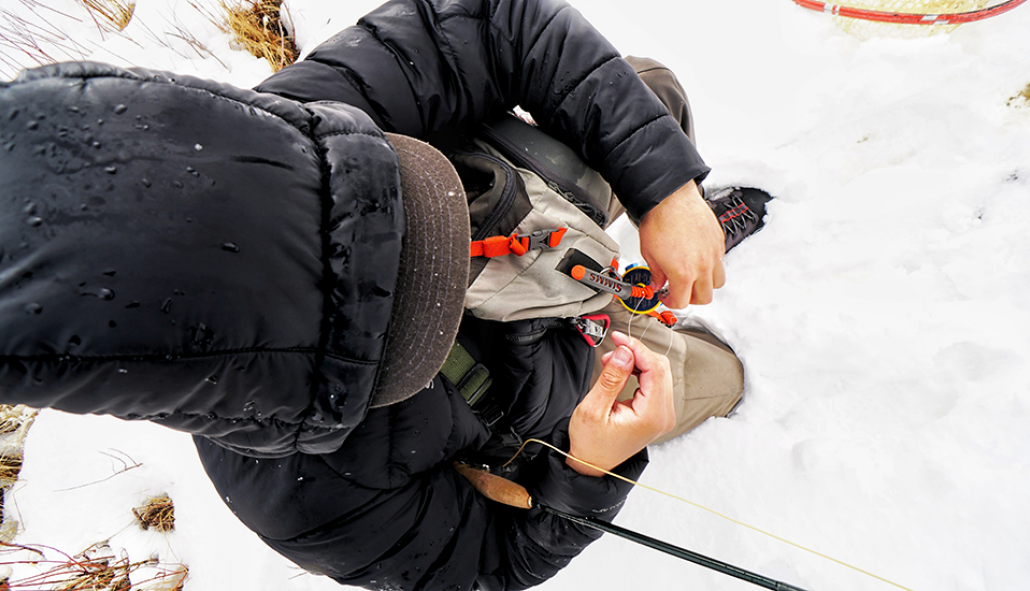Winter fly fishing is generally marked by lower water temperatures, lower flows, small bugs, and shorter days. While streamers can sometimes be effective in the winter, trout are sluggish during these extended periods of lower water temperatures and are typically more willing to feed on small midges, blue-winged olives, mysis shrimp and scuds (where available) rather than move any significant distance for a huge chunk of "meat." The lower water temperatures generally mean that trout are positioned around the bed of the river in slower, deeper water. As many of you know, nymphing is the most effective technique for picking up fish over the course of a winter day on the water. However, dry fly days aren't unheard of in the winter when the conditions are right (higher water temperatures and ample sun on the water), but the flies are typically size 20 and smaller.
With the winter fly fishing conditions described above, I firmly believe that you should fish with fluorocarbon tippet and only fluorocarbon tippet all winter long. Here's why:
- Fluorocarbon is a denser material than Nylon tippet. When nymphing to fish that are glued to the bed of the river, it pays to get your flies down as quickly as possible. Because fluorocarbon is denser than nylon, it sinks faster. That faster sink rate gets your flies into the feeding zone in less time and allows for a longer presentation on those pesky picky winter trout.
- Fluorocarbon has greater abrasion resistance than nylon. While summer fishing has it's fair share of hazards, there's no denying that winter is hard on fly line and tippet. Fighting a fish with wintery hazards like shelf ice, anchor ice, and of course in-stream rocks, using the more abrasion resistant fluorocarbon tippet is a no-brainer.
- Did I mention that Fluorocarbon is denser than Nylon tippet? Oh, I just did, well it just so happens that denser materials transmit energy more efficiently than less dense materials. Additionally, when wet, fluorocarbon stretches less than nylon tippet. What does that mean for you? Better feel. Low water temperatures, small bugs, and slow winter metabolisms mean that fish are generally less willing to move that far to eat and can result in more subtle eats in these colder months. The more feel the better when setting the hook on a subtle, wintertime eat. Another point for fluorocarbon.
- Fluorocarbon is "invisible" under water. Not to get too sciency, but fluorocarbon has a light refractive index that is very similar to freshwater's light refractive index. What does that mean? Fluorocarbon is harder to see when submerged in water than nylon tippet. Since you're most likely presenting subsurface flies during a winter day on the water, I would imagine you'd choose stealth if that option is available.
- Finally, if you happen to run into an opportunity to fish dry flies during a winter day on the water, I'd lay money that you'll be fishing flies size 18 and smaller. As a general rule, I use nylon tippet when I fish dry flies because nylon floats better than fluoro. However, when fishing a tiny dry fly during the low flows of winter, I will tie on a small 6-8 inch section of fluorocarbon to my fly. Why you might ask? Doesn't fluorocarbon sink? Yes, it does. However, nylon is reflective on the surface of the water. If I'm fishing tiny flies, I want to avoid tipping off that rising fish to my presence. Tippet that's visible on the surface can certainly tip off a wary, winter riser. By tying on 6-8 inches of fluorocarbon, I take advantage of the "invisible" property of the material. As fluorocarbon has the tendency to sink, I will generally shorten up my presentation, so as to get a more natural drift when the fly is actively being presented to the targeted riser.

